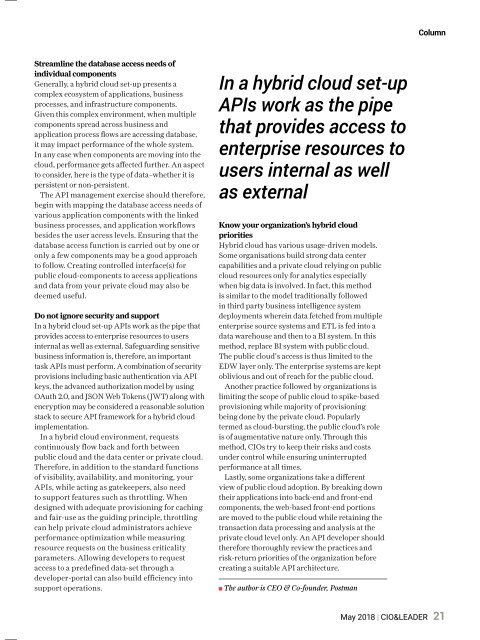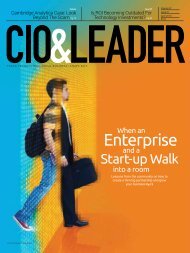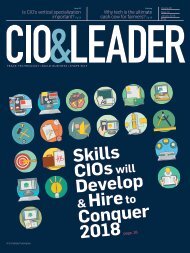C&L May 2018
Create successful ePaper yourself
Turn your PDF publications into a flip-book with our unique Google optimized e-Paper software.
Column<br />
Streamline the database access needs of<br />
individual components<br />
Generally, a hybrid cloud set-up presents a<br />
complex ecosystem of applications, business<br />
processes, and infrastructure components.<br />
Given this complex environment, when multiple<br />
components spread across business and<br />
application process flows are accessing database,<br />
it may impact performance of the whole system.<br />
In any case when components are moving into the<br />
cloud, performance gets affected further. An aspect<br />
to consider, here is the type of data–whether it is<br />
persistent or non-persistent.<br />
The API management exercise should therefore,<br />
begin with mapping the database access needs of<br />
various application components with the linked<br />
business processes, and application workflows<br />
besides the user access levels. Ensuring that the<br />
database access function is carried out by one or<br />
only a few components may be a good approach<br />
to follow. Creating controlled interface(s) for<br />
public cloud-components to access applications<br />
and data from your private cloud may also be<br />
deemed useful.<br />
Do not ignore security and support<br />
In a hybrid cloud set-up APIs work as the pipe that<br />
provides access to enterprise resources to users<br />
internal as well as external. Safeguarding sensitive<br />
business information is, therefore, an important<br />
task APIs must perform. A combination of security<br />
provisions including basic authentication via API<br />
keys, the advanced authorization model by using<br />
OAuth 2.0, and JSON Web Tokens (JWT) along with<br />
encryption may be considered a reasonable solution<br />
stack to secure API framework for a hybrid cloud<br />
implementation.<br />
In a hybrid cloud environment, requests<br />
continuously flow back and forth between<br />
public cloud and the data center or private cloud.<br />
Therefore, in addition to the standard functions<br />
of visibility, availability, and monitoring, your<br />
APIs, while acting as gatekeepers, also need<br />
to support features such as throttling. When<br />
designed with adequate provisioning for caching<br />
and fair-use as the guiding principle, throttling<br />
can help private cloud administrators achieve<br />
performance optimization while measuring<br />
resource requests on the business criticality<br />
parameters. Allowing developers to request<br />
access to a predefined data-set through a<br />
developer-portal can also build efficiency into<br />
support operations.<br />
In a hybrid cloud set-up<br />
APIs work as the pipe<br />
that provides access to<br />
enterprise resources to<br />
users internal as well<br />
as external<br />
Know your organization’s hybrid cloud<br />
priorities<br />
Hybrid cloud has various usage-driven models.<br />
Some organisations build strong data center<br />
capabilities and a private cloud relying on public<br />
cloud resources only for analytics especially<br />
when big data is involved. In fact, this method<br />
is similar to the model traditionally followed<br />
in third party business intelligence system<br />
deployments wherein data fetched from multiple<br />
enterprise source systems and ETL is fed into a<br />
data warehouse and then to a BI system. In this<br />
method, replace BI system with public cloud.<br />
The public cloud's access is thus limited to the<br />
EDW layer only. The enterprise systems are kept<br />
oblivious and out of reach for the public cloud.<br />
Another practice followed by organizations is<br />
limiting the scope of public cloud to spike-based<br />
provisioning while majority of provisioning<br />
being done by the private cloud. Popularly<br />
termed as cloud-bursting, the public cloud’s role<br />
is of augmentative nature only. Through this<br />
method, CIOs try to keep their risks and costs<br />
under control while ensuring uninterrupted<br />
performance at all times.<br />
Lastly, some organizations take a different<br />
view of public cloud adoption. By breaking down<br />
their applications into back-end and front-end<br />
components, the web-based front-end portions<br />
are moved to the public cloud while retaining the<br />
transaction data processing and analysis at the<br />
private cloud level only. An API developer should<br />
therefore thoroughly review the practices and<br />
risk-return priorities of the organization before<br />
creating a suitable API architecture.<br />
The author is CEO & Co-founder, Postman<br />
<strong>May</strong> <strong>2018</strong> | CIO&LEADER<br />
21














